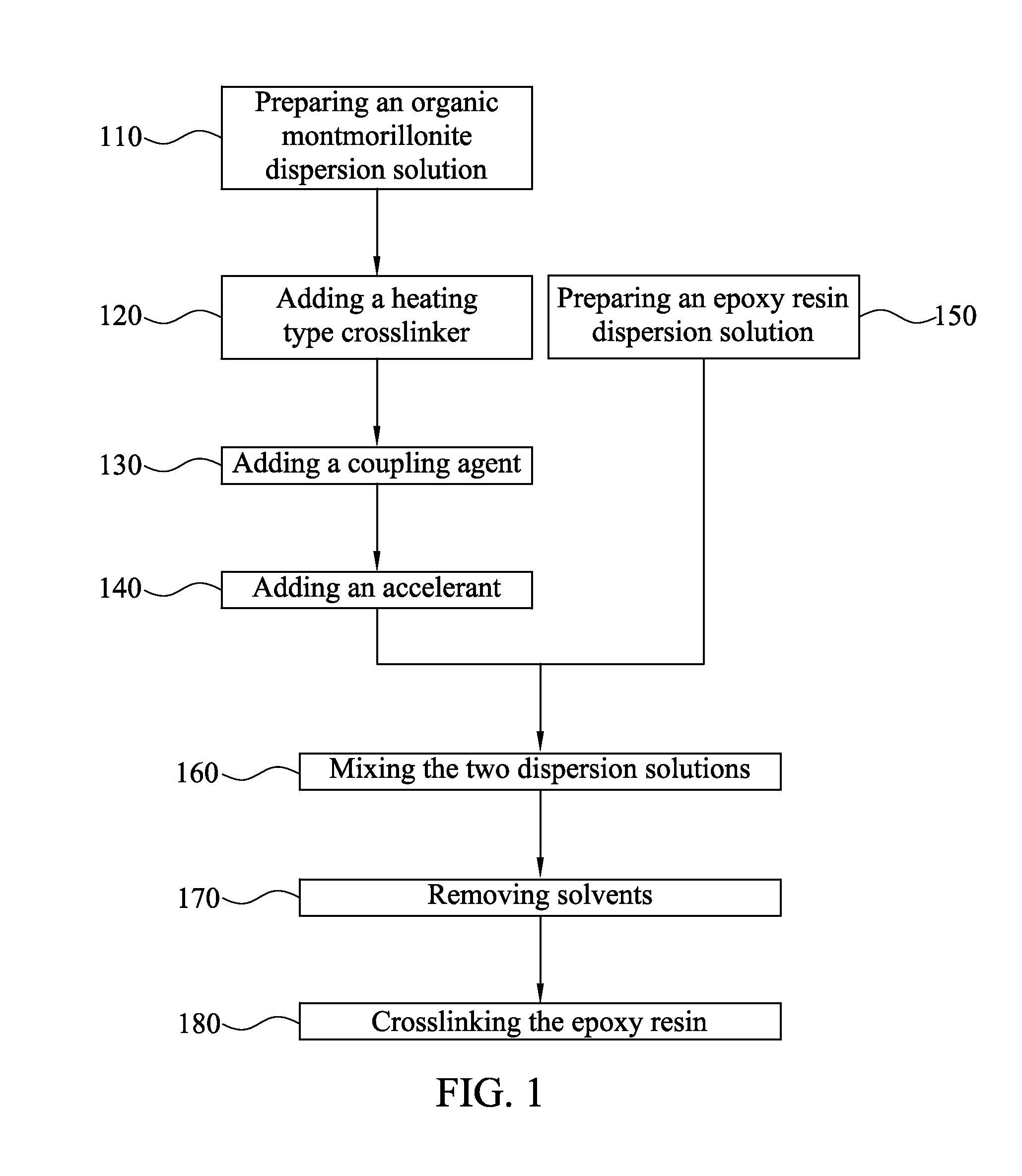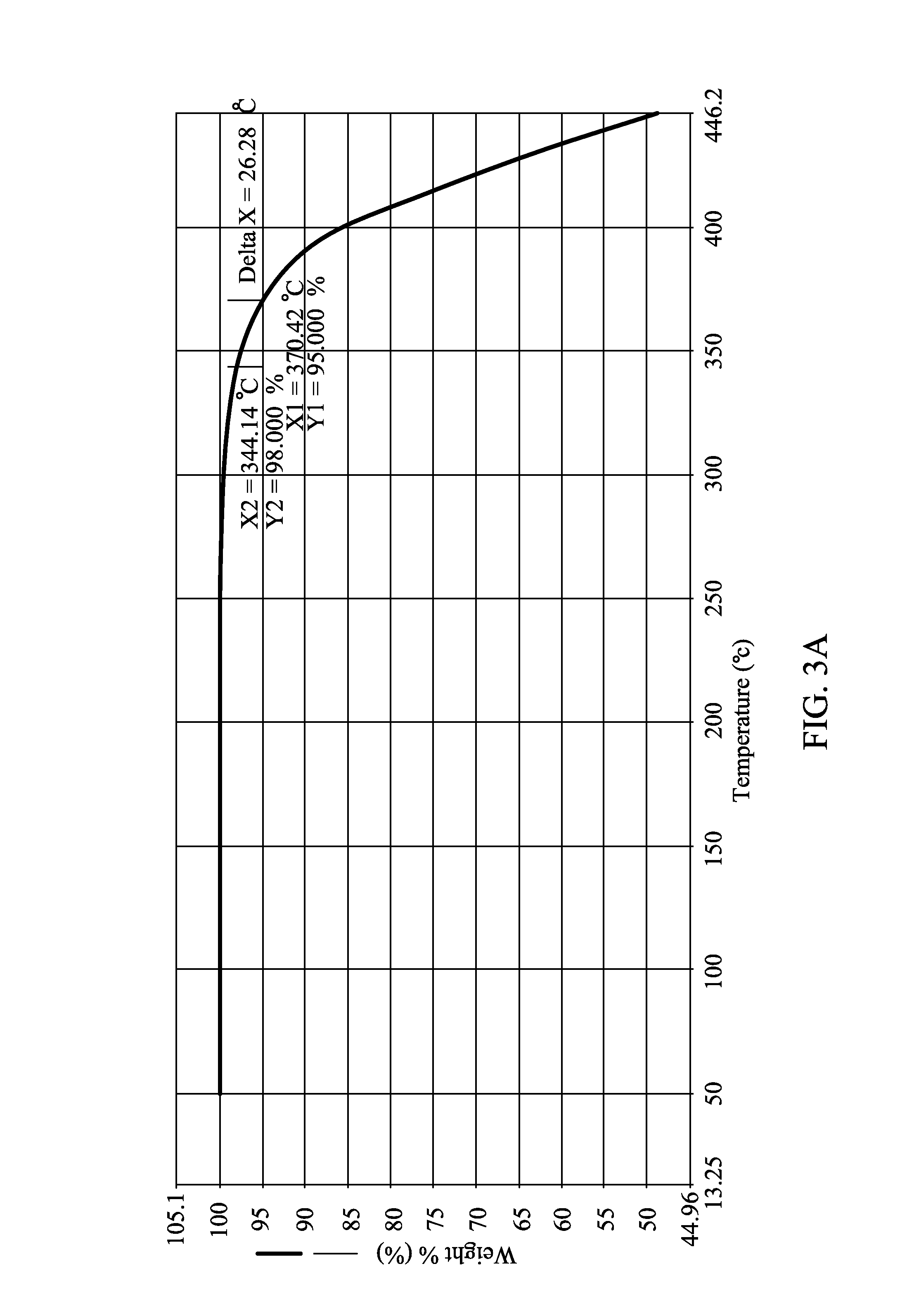Organic montmorillonite enhanced epoxy resin and preparation method thereof
a montmorillonite enhanced, epoxy resin technology, applied in the field of epoxy resins, can solve the problems of pcb delamination at 260° c. being shortened to about 10 minutes, pcb substrate damage in a rework process with an even higher temperature, and insufficient heat resistance of dicyandiamide cured halogen epoxy resins
- Summary
- Abstract
- Description
- Claims
- Application Information
AI Technical Summary
Benefits of technology
Problems solved by technology
Method used
Image
Examples
embodiment 1
Effect of Preparation Composition to Pyrolysis Temperature
[0049]In this embodiment, organic montmorillonite enhanced epoxy resins were prepared by following the process flow of FIG. 1. The epoxy resin E44 was dispersed in a mixed solvent of acetone and dimethyl formamide. Finally, the solvents of the mixed dispersion solution were removed at 100° C. The crosslinking reaction of the epoxy resin was performed at 130° C. for 2 hours, and then at 150° C. for 2 hours. The relative addition amount of each component to the epoxy resin and the pyrolyesis temperature of each example are listed in Table 1 below.
[0050]The pyrolysis temperature of the epoxy resin E44 without adding the organic montmorillonite was 320° C. Accordingly, most pyrolysis temperatures of examples 1-10 were 30-50° C. higher than the pyrolysis temperature of the epoxy resin E44. Comparing with some present techniques, such as that disclosed in the specification of CN 1250064. In CN 1250064, the pyrolysis temperature of ...
embodiment 2
Effect of Organic Montmorillonite to Pyrolysis Temperatures of Various Epoxy Resins
[0051]In this embodiment, organic montmorillonite enhanced epoxy resins were prepared by following the process flow of FIG. 1, and three types of epoxy resins were used to compare the pyrolysis temperatures under the same addition amount of the curing agent, the coupling agent, and the accelerant. The obtained results are listed in Table 2 below. From Table 2, it can be known that the pyrolysis temperatures of each epoxy resin were all increased. Especially the E44 epoxy resin, the pyrolysis temperature was increased by 40° C.
TABLE 2Effect of organic montmorillonite to pyrolysis temperatures ofvarious epoxy resins. The listed weight percent of each component was basedon the weight of the epoxy resin.2organic3curing6pyrolysis1Epoxymontmorilloniteagent4coupling5acceleranttemperatureExamplesresin(wt %)(wt %)agent (wt %)(wt %)(° C.)11E440340.233010E443340.237012E510340.234513E513340.23611460010540.2299156...
embodiment 3
Effect of Accelerant to Pyrolysis Temperature
[0052]In this embodiment, organic montmorillonite enhanced epoxy resins were prepared by following the process flow of FIG. 1. The preparation conditions of the example 10 and 16 were all the same, except the accelerant. In example 10, the accelerant was 2,4,6-tris(dimethylaminomethyl)phenol. In example 16, the accelerant was 2-ethyl-4-methyl imidazole. The obtained pyrolysis temperatures are listed in Table 3 below. From Table 3, it can be known that the type of the accelerant has a considerable influence on the pyrolysis temperature. The pyrolysis temperature was increased by the curing agent of 2,4,6-tris(dimethylaminomethyl)phenol in example 10, and the pyrolysis temperature was decreased by the curing agent of 2-ethyl-4-methyl imidazole in example 16.
TABLE 3Effect of accelenant to pyrolysis temperature. The listed weightpercent of each component was based on the weight of the epoxy resin.2organic3curing6pyrolysis1Epoxymontmorillonite...
PUM
| Property | Measurement | Unit |
|---|---|---|
| heat resistance | aaaaa | aaaaa |
| temperature | aaaaa | aaaaa |
| temperature | aaaaa | aaaaa |
Abstract
Description
Claims
Application Information
 Login to View More
Login to View More - R&D
- Intellectual Property
- Life Sciences
- Materials
- Tech Scout
- Unparalleled Data Quality
- Higher Quality Content
- 60% Fewer Hallucinations
Browse by: Latest US Patents, China's latest patents, Technical Efficacy Thesaurus, Application Domain, Technology Topic, Popular Technical Reports.
© 2025 PatSnap. All rights reserved.Legal|Privacy policy|Modern Slavery Act Transparency Statement|Sitemap|About US| Contact US: help@patsnap.com



